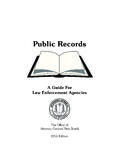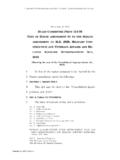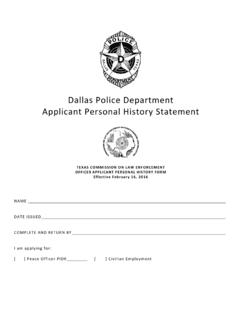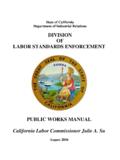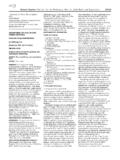Transcription of Additional Guidance - NASHiCS
1 Good Practice Guidance 2016 for application to HM Government guide to Fire Safety Risk Assessment Residential Care Premises Additional Guidance Valid from July 2016 - January 2019 Page 2 of 16 Additional Guidance agreed between the National Association for Safety and Health in Care Services ( NASHiCS ). and the Chief Fire Officers Association (CFOA), Business Safety Group for application to HM Government guide to Fire Safety Risk Assessment Residential Care Premises. Valid from July 2016 - January 2019 Page 3 of 16 Contents 1. Information 4 2. Purpose and Scope 4 3. Responsibilities 5 4. Additional Guidance 6 5. Period and Review 10 Appendices APPENDIX 1.
2 National Association for Safety and 12 Health in Care Services ( NASHiCS ) NASHiCS Fire Safety Working Group APPENDIX 2. The role of the Care Quality Commission 14 APPENDIX 3. The nature of residential care premises 15 APPENDIX 4. The role of the Fire and Rescue Service 16 Chief Fire Officers' Association (CFOA) 16 CFOA Business Safety Group (BSG) Valid from July 2016 - January 2019 Page 4 of 16 1. INFORMATION The Communities and Local Government guide to Fire Safety Risk Assessment for Residential Care Premises (CLG guide ) was published by HM Government to provide Guidance regarding compliance with the Regulatory Reform (Fire Safety) Order 2005 (FSO). The principle enshrined in the FSO is that residential care premises operators have a duty to ensure, as far as reasonably practicable, the safety of their employees, residents and other visitors.
3 They are to use a Fire Risk Assessment (FRA) approach to identify and control the fire risks in their premises. NASHiCS members acknowledge the self-compliance aspect of the FSO, and recognise that the Fire and Rescue Service is the Enforcing Authority for the FSO. 2. PURPOSE AND SCOPE As a result of holding discussions with members, NASHiCS set up the Fire Safety Working Group to examine a number of the issues raised and to establish practical methods of compliance. The CLG guide was produced to help residential care premises operators comply with the FSO by explaining the process of the FRA, suggesting control measures appropriate to residential care premises, and identifying some general fire precautions. It is important to remember that the CLG guide is NOT prescriptive but best practice; it should be read as a whole and not used selectively.
4 The NASHiCS Fire Safety Working Group identified some specific issues in the CLG guide that seem to require some Additional Guidance in order to ensure full understanding by all concerned. This document is designed to set out this Additional Guidance and deal with the following issues: evacuation of a protected zone in minutes; rooms of residents unable to evacuate upgrading to 60 minutes fire resistance; staff remaining with residents who are unable to evacuate; the use of external fire escapes by residents; the travel distance of evacuation routes; the use of by-pass routes. Valid from July 2016 - January 2019 Page 5 of 16 The Fire Safety Working Group acknowledge that fire safety officers in England and Wales are governed by Regulators Code and make use of an Enforcement Management Model within their audit process in order to provide consistency of approach to the FSO and the use of the CLG guide and other appropriate Guidance .
5 (Similar arrangements are in place within in devolved administrations). NASHiCS welcomes these efforts and will work with the various operators and the Fire and Rescue Service to ensure compliance and continuing clarity and understanding of the complex issues involved in fire safety in residential care premises. This Additional Guidance document has been published to provide Residential Care Premises operators with understanding of the CLG guide and how it helps to ensure compliance with the requirements of the FSO. Underlying principles: The safety of premises occupants is paramount; Staff training as regards awareness and reduction of the risk of fire and in evacuation strategies and techniques is vital; The risk of fire cannot be completely eliminated so measures must be in place to reduce the risk to as low as reasonably practicable; as required by the law; There should be sufficient levels of staff to effect the fire safety strategy (including evacuation strategy) for that premises; The fire safety strategy should always take account of the ability of the building to withstand the spread of fire and smoke travel.
6 3. RESPONSIBILITIES Residential Care Premises operators are responsible under the FSO for identifying fire hazards, implementing appropriate controls, managing residual risks and ensuring staff are trained. The key to this is making a suitable and sufficient assessment of the risks in case of fire and documenting the significant findings (what has been and what will be done to provide safety) and any persons identified as being especially at risk. This should include: information on building - height, size, processes etc.; information on occupants (must record those especially at risk) - numbers, vulnerability; fire loss experience - previous history of unwanted fire signals (false alarms), enforcement action if prevalent; Valid from July 2016 - January 2019 Page 6 of 16 fire hazards and control measures - to prevent fire starting and spreading; fire protection measures means of escape, means of warning, signage; management of fire safety policies, procedures, training, drills, testing, maintenance, records; assessment of risk; prioritised action plan agreed by the Responsible Person.
7 The outcome of the FRA should include an assessment of the risks, and be the basis of the fire safety strategy (this includes the evacuation strategy that aims to protect the safety of people in the building). Responsibilities of Residential Care Premises operators include ensuring buildings meet acceptable standards of fire and smoke protection in order to support the fire safety strategy, installing and maintaining suitable fire detection systems and emergency lighting and providing and maintaining adequate escape routes and fire exits. 4. Additional Guidance (i) Evacuation of a protected zone in minutes: CLG guide : It is acknowledged that in the event of a fire residents need to be moved as quickly as possible to a place of safety. The CLG guide states that under normal operating conditions it should be possible to evacuate any given protected area in minutes (CLG guide , Section , ) Additional Guidance : In most cases a min evacuation time is unlikely to be achievable, depending on the mobility status of residents and the numbers of staff available on some shifts (in particular on night shifts).
8 However, it should be noted that the CLG guide states that the min should be seen as a starting point upon which to make an assessment and that longer evacuation times could be accepted, so long as every effort is made to reduce the time taken and the risk is mitigated by adjustment of other appropriate factors. (CLG guide , ). Other appropriate factors could include: Automatic Water Suppression Systems; Additional compartmentation; Additional staff; Reduced compartment sizes. (This list is not exhaustive). Valid from July 2016 - January 2019 Page 7 of 16 (ii) Rooms of residents unable to evacuate upgrading to 60 minutes fire resistance: CLG guide : The CLG guide states that in exceptional cases, it may not be possible to immediately move some residents to an adjoining protected zone or to a refuge (CLG guide , Section , p.)
9 71). In these cases, a residents room may need to provide a temporary refuge by being in itself a protected bedroom. The CLG guide goes on to say that a protected bedroom should be of 60 minutes fire resisting construction, with the escape route from the bedroom to a place of safety outside the building also having a higher level of protection. It is further suggested that any resident left in a protected bedroom should be accompanied by a carer (see (iii) below). Additional Guidance : In most care homes, it may be impractical to upgrade individual rooms (if the rooms have minimum 30 minutes fire resistance) ; however, if any alterations to fire precautions takes place then, subject to the outcome of the FRA, the compartmentation should be increased to 60 minutes.
10 In many care homes, compartmentation may be only 30 minutes and not the 60 minutes suggested. In such cases a survey should be undertaken and an upgrade programme documented and time scales given. (iii) Staff remaining with residents who are unable to evacuate: CLG guide : The CLG guide states Any resident who is initially left in a fire protected bedroom should be accompanied by a carer . (CLG guide , p. 71) Additional Guidance : Those staff on duty may be of most use in assisting the horizontal evacuation strategy, although consideration must be given to the distress this can cause to the resident. It is expected that every effort will be made by Residential Care Premises Operators to reduce the risk to any person. The following arrangements are examples of the efforts that must be made: In many care homes the evacuation strategy is Progressive Horizontal Evacuation (PHE) which will be carried out in stages.

